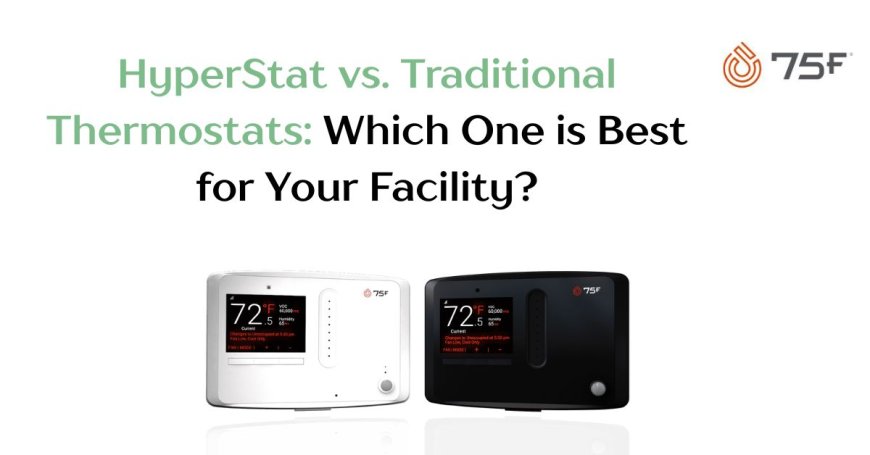HyperStat vs. Traditional Thermostats: Which One is Best for Your Facility?
Compare the 75F HyperStat with traditional thermostats to discover how smart controls boost energy efficiency, comfort, and long-term savings.

When it comes to controlling the temperature in commercial buildings, selecting the right thermostat is crucial to achieving both energy efficiency and occupant comfort. Traditionally, many facilities have relied on conventional thermostats, but with advancements in smart building technology, the 75F HyperStat has emerged as a more intelligent alternative. Here’s a comparison between the 75F HyperStat and traditional thermostats, and how each can impact your facility's energy use, comfort, and cost savings.
1. Smart Technology vs. Manual Control
75F HyperStat:
The 75F HyperStat is a smart thermostat designed to automate and optimize climate control in commercial buildings. Unlike traditional thermostats, the HyperStat connects to the 75F cloud platform, allowing for remote control, real-time monitoring, and data-driven adjustments. The system uses sensors to track occupancy, temperature, humidity, and air quality, adjusting HVAC settings automatically based on real-time data. This leads to more efficient energy use, as HVAC systems are only active when necessary.
Traditional Thermostats:
Traditional thermostats, on the other hand, are manually adjusted by occupants or facility managers. While they can maintain a set temperature, they lack the intelligence to adjust in real time or respond to changing environmental conditions. These thermostats can lead to energy waste, as they continue running even when spaces are unoccupied or when external conditions change.
2. Energy Efficiency
75F HyperStat:
The HyperStat is designed to significantly reduce energy consumption by adjusting HVAC operations based on occupancy and environmental conditions. With occupancy-based control, the system ensures energy is only used when needed. For instance, when a room is empty, the HyperStat can reduce heating or cooling, optimizing energy efficiency without sacrificing comfort. This leads to reduced utility costs and a lower carbon footprint for the facility.
Traditional Thermostats:
Traditional thermostats often lead to energy waste, as they continue to operate commercial HVAC systems regardless of occupancy or external temperature changes. For example, if a room is empty, the system may still be cooling or heating it according to a pre-set schedule. This results in energy waste and higher costs.
3. Ease of Use and Control
75F HyperStat:
The HyperStat offers advanced features like remote access via the 75F mobile app or web platform, making it easier to control multiple thermostats in a building from anywhere. Facility managers can view real-time energy usage data, set schedules, and make adjustments remotely. The system also provides predictive maintenance alerts, identifying issues before they become costly problems.
Traditional Thermostats:
Traditional thermostats are often simple and easy to use but lack the advanced features offered by smart systems. While basic models allow users to set desired temperatures, they don’t provide remote access or data insights. Maintenance and adjustments also need to be made manually, often resulting in inefficiencies.
4. Customization and Comfort
75F HyperStat:
The 75F HyperStat provides a higher level of comfort customization, adjusting temperatures based on individual room needs. For instance, if a space is overly warm or cool, the system can detect the discrepancy and make adjustments in real time, ensuring comfort without manual intervention. Additionally, the system can maintain optimal humidity levels and air quality, ensuring a healthier environment for occupants.
Traditional Thermostats:
While traditional thermostats maintain a set temperature, they don’t adjust for environmental factors such as humidity or air quality. Occupants may experience temperature fluctuations, especially in larger or multi-zone buildings, as these systems are often unable to accommodate individual preferences or automatically adjust for changes in the environment.
5. Cost and ROI
75F HyperStat:
While the initial cost of a 75F HyperStat may be higher than that of traditional thermostats, the system’s energy-saving features provide a rapid return on investment (ROI). Reduced energy consumption, fewer HVAC repairs, and optimized energy management result in long-term cost savings. Additionally, smart systems like the HyperStat may help buildings qualify for incentives or rebates through energy-saving programs.
Traditional Thermostats:
Traditional thermostats have a lower upfront cost, but they may result in higher long-term operational costs due to energy inefficiency. Over time, these systems lead to increased utility bills and greater wear on HVAC systems, which can translate into additional repair and maintenance costs.
6. Integration with Building Systems
75F HyperStat:
The HyperStat is part of a larger suite of smart building solutions from 75F. It can easily integrate with other building automation systems, such as lighting, HVAC, and ventilation, creating a fully automated ecosystem. This integration allows for centralized control, improving overall building management and operational efficiency.
Traditional Thermostats:
Traditional thermostats typically operate as standalone devices and are often not integrated with other building systems. This limits their ability to contribute to broader building optimization efforts and results in fragmented management.
Which One is Best for Your Facility?
75F HyperStat is the ideal choice for businesses or building managers looking to optimize energy use, improve occupant comfort, and achieve sustainability goals. It offers advanced automation, remote control, and real-time data insights that help reduce energy waste and operating costs.
On the other hand, if you're managing a smaller facility or if cost is a primary concern, traditional thermostats may still provide adequate control but may lack the efficiency, flexibility, and long-term savings that come with smarter solutions like the 75F HyperStat.
For facilities aiming to reduce their carbon footprint, improve operational efficiency, and maximize energy savings, 75F HyperStat is the clear winner.
What's Your Reaction?

















































